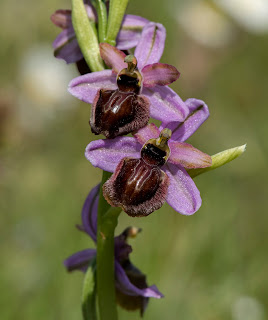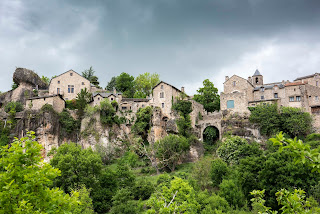The Cevennes and the Grands Causses, of which the Aveyron is a part, is a naturalist's paradise.
Think deep gorges, mossy woodland, gentle hills, flower filled meadows and windswept plateaux......it is truly glorious. Together they form the SE part of the Massif Central in southern France.
The Grands Causses are rugged limestone plateaux, intersected by spectacular gorges cut by the rivers Lot, Tarn, Jonte and Dourbie.
The Caussse Sauveterre is between the Lot and the Tarn.
The Causses Mejean is between the Tarn and the Jonte.
The Causse Noir is between the Jonte and the Dourbie.
The Causses Larzac is between the Dourbie and the Mediterranean plain.
There are several smaller Causses that flank the 'big four'.
The Aveyron is a department of France located in the N of the Occitanie region of southern France......named after the river Aveyron.
It lies south of the Massif Central and is divided into several regions, including the Grand Causses and the Cevennes National Park.
Aveyron was one of the original 83 departments created during the Revolution in 1790 it is the site of the world's tallest bridge at Millau, the Millau Viaduct , and home of the world famous Roquefort cheese from the village of the same name. Ten of its towns are classified as Les Plus Beaux Villages de France. However, for me the greatest attractions of the Aveyron are the orchids.
The Cevennes and the Grands Causses are amongst the best regions for finding wild orchids in the whole of Europe. According to some experts there are no less than 61 species present in the area. Most are confined to the limestone areas.....the Causses and the surrounding hills in the S and E of the area. It is also possible to find some very special orchids on the granite and schist....including the elusive Ghost Orchid, Epipogium aphyllum.
Our visit was timed to make the most of the species that flower in May and we were not disappointed. However, it was far too early for the little Ghosts....another trip ? I hope so.
Identifying orchids can be a bit tricky, due to the many recent and ongoing changes in taxonomy.
Books are helpful:
'Guide des orchidees de france, de Suisse et du Benelux' by Pierre Delforge
'Les Orchidees sauvages des Causses et Cévennes' by Denis Andre
'Ophrys, The Bee Orchids of Europe' by Henrick Pedersen and Niels Faurholdt
But most helpful of all has been Cedric Rajadel, Photographer and all round lovely man. Born in Paris and living in the Aveyron with his young family. He was generous with his time, his knowledge of the area and his love of orchids. He even shared his lovely family with us.
Our other guide for the trip was a fabulous little book, A Crossbill Guide, 'Cevennes and Grands Causses'.
Our base for 2 glorious weeks was the spectacularly beautiful village of Cantobre, situated on the western edge of the Cevennes National Park at the junction of the Dourbie and Trevezel rivers. The village is built on the site of a 12th century castle, perched on a rock at almost 600m above sea level. The castle was destroyed during the 17th century religious wars. The present village evolved over the centuries to become a home for peasants who worked the hillside and in the local mines. It became de-populated by mid 20th century due to the end of mining and the general movement from countryside to towns. However, over the last 30 years or so the village has blossomed and been steadily re-built. The skyline is dominated by the 12th century church which overlooks the village square. It is an absolute delight.
Our hosts were the spectacularly beautiful Peggy and Lionel Haines whose kindness and generosity will never be forgotten.
And a very special thank you to Cedric Rajadel , Photographer and all round beautiful person from Millau who shared his knowledge and love of orchids, and introduced us to his lovely family.
The photographs are all taken by me ....using my much loved Nikon D810 with its dedicated 105mm macro lens. Sometimes I used flash, often I used a reflector to bounce light into the shadows on the bright sunny days. Sometimes I even used a white umbrella to diffuse the bright sunlight. Always I was accompanied by my partner and soul mate Robin.....who was often called upon the hold the reflector.
I will use Latin names for orchids successfully identified....in order to avoid any confusion.
Causse du Larzac
Lapanouse de Cernon
Also on the Causse du Larzac, there is a site near to La Pezade that is an absolute delight. There are many species to be found here, including Dactylorhiza viridis, D. sambicina Orchis simia, O.purpurea, Ophrys insectifera, and the rare and endemic Ophrys aymoninii.......plus the largest group of Pasque Flowers I have ever seen.
 |
| Pulsatilla rubra |
 |
| Orchis purpurea |
 |
| Anacamptis morio (alba) |
 |
| Ophrys aymoninii |
 |
| Ophrys scolopax |
 |
| Ophrys aveyronensis |
 |
| Dactylorhiza sambucina |
 |
| Anacamptis pyramidalis |
 |
| Orchis ustula |
 |
| Dactylorhiza viridis |
 |
| Dactylorhiza fuchsii |
 |
| Ophrys insectifera |
 |
Ophrys x hybrida
(insectifera x sphegodes) |
 |
Orchis bergonii
( a hybrid of Orchis simia and orchis anthropophera) |
 |
| Ophrys aranifera |
Causse Blandas
The Causse Blandas is a limestone karst plateau characterised by rocky hills covers by grasslands and open scrub. A short tour from just east of Alzon on the D158 takes you up onto the Causse, through to the village of Blandas and on to the magnificent Cirque de Navacelles. It is said that this is the best birdwatching area in the whole of the Cevennes.
It's not bad for flora either.
On the roadside near to Alzon we saw hundreds of Orchis simia and Orchis anthropophora. The two produce hybrids which can be easily spotted, along with their parents. We also spotted the odd Serapias lingua plus the spectacularly beautiful dwarf iris, Iris lutescens in the blue and yellow forms.
 |
This photograph shows the diminutive
'parents' O. simia and O. anthropophera
with their robust hybrid offspring Orchis bergonii |
 |
| Orchis simia, white version |
 |
| Orchis bergonii |
 |
| Limodore abortivum |
 |
| Serapias lingua |
 |
| Anacamptis pyramidalis |
 |
| Ophrys apifera |
 |
| Iris lutescens |
 |
| Anthirrhinum |
 |
| Iris lutescens |
 |
| Iris lutescens |
Causse Begon and Mont Aigoual
This route took us from our base at Cantobre, up on to the Causse Begon via St Jean de Bruel. St Jean de Bruel is a delightful little town located in a beautiful green valley. Historically a protestant town it suffered badly during the Wars of Religion. The single arch bridge over the river dates from the 13th century and the pretty streets have names that evoke past activities such as Cooperage, Potters and Sabotiers. A the Col de laPierre Plantee a narrow track leads on to the Causse Begon.
The flora is impressive up here. There is a short walk of around 30mins, a loop around a large grassy area where we found thousands of orchids.
 |
(L) Orchis simia
with Orchis bergonii (O simia x O anthropophora |
 |
| Orchis anthropohora |
 |
| Orchis ustulata |
 |
| Orchis mascula |
From the Col we travelled on towards Dourbies. At the entrance to the village, in a damp area near to a small bridge we found some glorious examples of Dactylorhiza elata.
 |
Dactylorhiza elata
with Veronica chamaedrys |
From Dourbies we headed up towards the summit of Mont Aigoual and by the roadside we found the odd wild Tulip, some Narcissus and lots and lots of Dactylorhiza sambucina.....both the yellow and the red.
 |
| Orchis sambucina |
 |
| Orchis sambucina |
 |
| Orchis sambucina |
The top of the mountain is reached by road, and at over 5000ft it is a cold and windy spot.
The views though are staggeringly beautiful......all the way down to the Mediterranean coast. This mountain is often called the 'deluge capital of southern Europe". There is a record of 950mm of rain falling during one single night in September. Meteo France have a weather station and an exhibition there, but we found it was too cold to linger for very long. We returned to Cantobre via the Trezeval Gorge, through very picturesque scenery
Around Millau
My first meeting with Cedric Radajel was on line...we shared and commented on photographs on Facebook. As soon as he knew we were planning a trip to the Grands Causses he offered to meet with us and introduce us to some of the best sites for orchids.
Our day began with a 9am meeting in the MacDonalds car park in Millau. What followed was a 'magical mystery tour' of botanical delights.
I had spent the winter months researching the area in books. I had bought a copy of 'Les orchidees savages des Causses et Cevennes" by Denis Andre a couple of years earlier in a supermarket in the Aude region of France. I knew what there was .....some very rare and beautiful orchids indeed. However, I thought it may be not be easy. So the offer of a guide was brilliant.
In the book, is a photograph of the very rare and endangered Anacamptis papilionacea, var. grandiflora. A spectacularly beautiful orchid with large pink flowers. The photograph showed the plant and a backdrop of the viaduct at Millau. I never expected to be able to find the exact spot.....they grow on only 2 sites in the whole of France.
Cedric asked if we wanted to see something very special and took us to the very spot! I was SO excited.
It was a bit of a scramble, up a hillside, through a little wooded area and up another steep slope out onto an open grassy area. There were hundreds of these little beauties.
But, not only that....Cedric had discovered hybrid growing in this area. Anacamptis x menosii, a hybrid of Anacamptis papilionacea var. grandiflora x Anacamptis coriophera ssp. fragrans. We caught it as it was just beginning to open up. Such a treat!
In and around the same area we also saw the Ophrys aveyronensis and O. scolopax......and Cephalanthera damasonium. Plus others, illustrated below.
 |
Anacamptis menosii
|
 |
| Cephalanthera chlorantha |
 |
| Cephalanthera damasonium |
 |
| Orchis mascula |
 |
| Orchis ustulata |
 |
| Ophrys aveyronensis |
 |
| Ophrys scolopax |
 |
| Galdiolus italicus |
Thank you Cedric....and Andy ( son of Cedric) for a very special day.
Back to the Larzac
This really is a very special place . We spent a lot of our 2 weeks in this area and would go back at the drop of a hat. It is a paradise for botanists but there is also a lot of history to explore too. A visit to la Couvertoirade is a must.
la Couvertoirade
This medieval village on the Larzac plateau reflects the military power of the Knights Templars and the Knights of St. Jean ( known as the Hospitaliers). The Templars built the castle in the 12th century. After the abolition of the Templars in 1312, la Couvertiordae was given to the Hospitaliers who built the church of St. Christophe in 14th century and the enclosure and towers a hundred years later.
The village is beautifully restored. An old fortified gateway leads into a meandering of streets, covered passageways and 15th century houses. You can walk the ramparts and view the surrounding countryside....including an old windmill on the hill.
Steps cut into the rocked to the church which has some lovely contemporary stained glass. There are also artisan boutiques and shops to explore, a cafe and a bakery.
Well worth a visit.
 |
Stained glass window in the church of St. Christophe.
The work of master glass worker Claude Baillon. |
 |
Carlina acanthifolia, Carline Thistle
This acanthus -leaved thistle is often seen attached
to doors of houses and other buildings on the Causses.
It is a low-growing perennial which can reach
around 50cm across. The plant thrives on limestone between
500m and 1800m. It is a are and vulnerable species.
Historically it was collected and cooked....said to be similar
to artichoke. It was also used to make jam and has
also been used to cure wounds, influenza and eczema!
There is even an old story about it being used to cure
the plague. It is said to be a symbol of good luck and
protection. |













































































Comments
Post a Comment